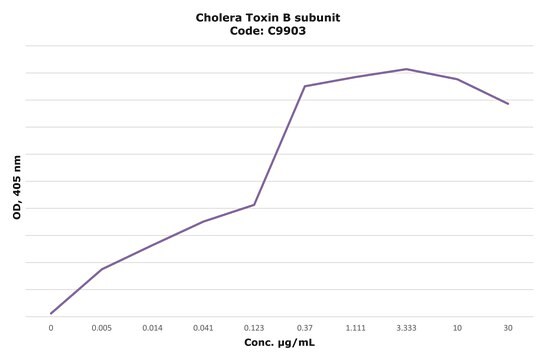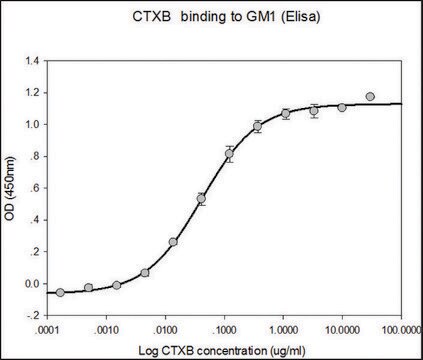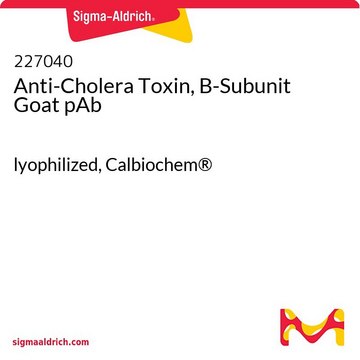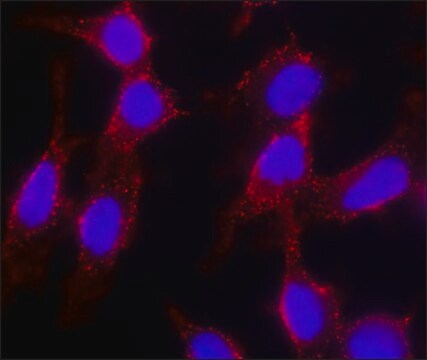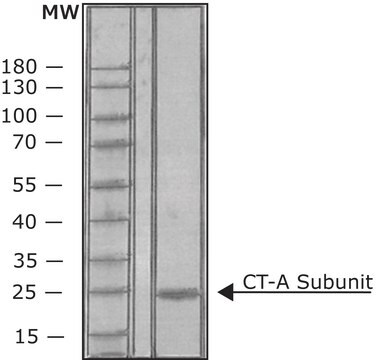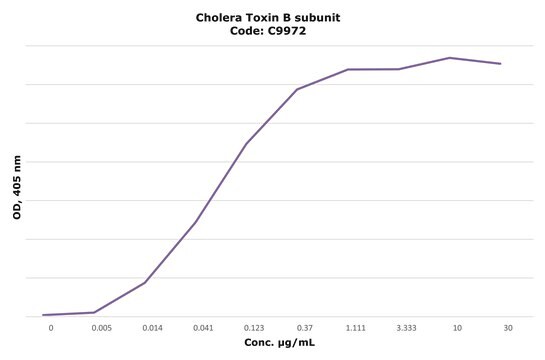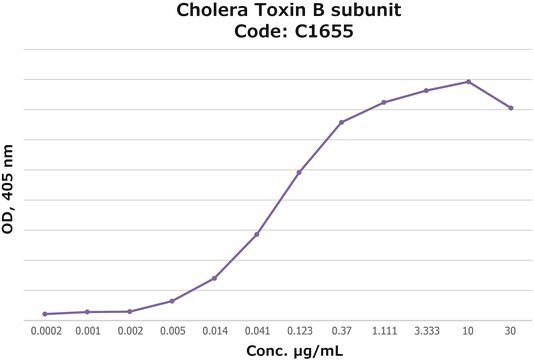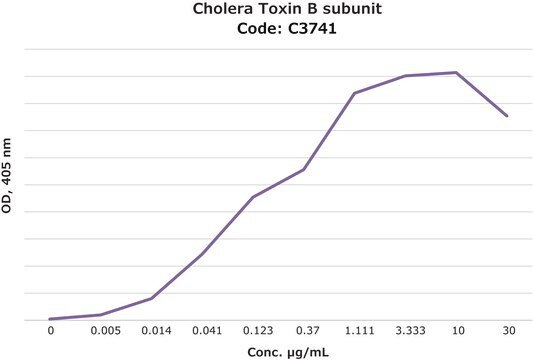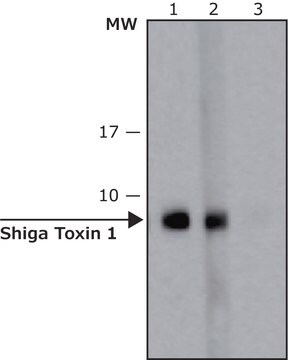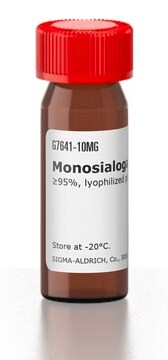C3062
Anti-Cholera Toxin antibody produced in rabbit
whole antiserum
Sinónimos:
Cholera Toxin Antibody
Iniciar sesiónpara Ver la Fijación de precios por contrato y de la organización
About This Item
Productos recomendados
biological source
rabbit
Quality Level
conjugate
unconjugated
antibody form
whole antiserum
antibody product type
primary antibodies
clone
polyclonal
contains
15 mM sodium azide
technique(s)
Ouchterlony double diffusion: 1:16
dot blot: 1:20,000
indirect ELISA: 1:8,000
shipped in
dry ice
storage temp.
−20°C
target post-translational modification
unmodified
General description
Cholera toxin, the pathogenic agent of cholera, is made of two subunits, A (27 kDa) and B (12 kDa) assembled with the stoichiometry AB5. The B-subunit binds to specific receptors, the monosialogangliosides GM1, located in the membrane of intestinal epithelial cells. The A1 fragment of the A-subunit is translocated through the membrane of the host cell, where it catalyses the ADP-ribosylation of the Gsa regulatory component of the adenylate cyclase complex. The resulting increased level of cyclic AMP promotes a wide variety of actions, including the secretion of chloride ions in the case of intestinal epithelial cells.
The antiserum reacts versus Cholera toxin, but shows no reaction versus Staphylococcal enterotoxin A, Staphylococcal enterotoxin B and Pseudomonas exotoxin A (protein concentration: 50-500 ng/dot). The product has not been tested for neutralization potency against active Cholera toxin.
Immunogen
toxin from Vibrio cholerae
Application
Anti-Cholera Toxin antibody produced in rabbit has been used in:
- western blotting
- quantitative ganglioside-dependent enzyme-linked immunoassay (ELISA)
- double immunodiffusion
Biochem/physiol Actions
Cholera toxin (CT), a multifunctional protein plays a role in the immune system. It possesses immunomodulatory, adjuvant properties and also acts as an anti-inflammatory agent. Its immunomodulatory properties can be utilized to treat several autoimmune disorders. CT can serve as one of the best model of a multifunctional protein.
Preparation Note
delipidized
Disclaimer
Unless otherwise stated in our catalog or other company documentation accompanying the product(s), our products are intended for research use only and are not to be used for any other purpose, which includes but is not limited to, unauthorized commercial uses, in vitro diagnostic uses, ex vivo or in vivo therapeutic uses or any type of consumption or application to humans or animals.
¿No encuentra el producto adecuado?
Pruebe nuestro Herramienta de selección de productos.
Storage Class
12 - Non Combustible Liquids
wgk_germany
WGK 1
flash_point_f
Not applicable
flash_point_c
Not applicable
Elija entre una de las versiones más recientes:
¿Ya tiene este producto?
Encuentre la documentación para los productos que ha comprado recientemente en la Biblioteca de documentos.
Los clientes también vieron
Dazhi Jin et al.
Journal of clinical microbiology, 51(12), 3968-3974 (2013-09-21)
We report here the quantitative detection of Vibrio cholerae toxin (CT) in isolates and stool specimens by dynamic monitoring of the full course of CT-mediated cytotoxicity in a real-time cell analysis (RTCA) system. Four cell lines, including Y-1 mouse adrenal
Generation and characterization of a live attenuated enterotoxigenic Escherichia coli combination vaccine expressing six colonization factors and heat-labile toxin subunit B
Turner AK, et al.
Clinical and Vaccine Immunology : CVI, 18(12), 2128-2135 (2011)
Qiyao Wang et al.
Infection and immunity, 83(9), 3381-3395 (2015-06-10)
Diverse environmental stimuli and a complex network of regulatory factors are known to modulate expression of Vibrio cholerae's principal virulence factors. However, there is relatively little known about how metabolic factors impinge upon the pathogen's well-characterized cascade of transcription factors
Tatiana El Hage et al.
The FEBS journal, 274(10), 2614-2629 (2007-04-25)
Using the in situ liver model system, we have recently shown that, after cholera toxin binding to hepatic cells, cholera toxin accumulates in a low-density endosomal compartment, and then undergoes endosomal proteolysis by the aspartic acid protease cathepsin-D [Merlen C
Christine A Pellino et al.
Journal of bacteriology, 198(11), 1621-1630 (2016-03-24)
Shiga toxin (Stx)-producing Escherichia coli (STEC) is a major cause of foodborne illness, including the life-threatening complication hemolytic-uremic syndrome. The German outbreak in 2011 resulted in nearly 4,000 cases of infection, with 54 deaths. Two forms of Stx, Stx1 and
Nuestro equipo de científicos tiene experiencia en todas las áreas de investigación: Ciencias de la vida, Ciencia de los materiales, Síntesis química, Cromatografía, Analítica y muchas otras.
Póngase en contacto con el Servicio técnico